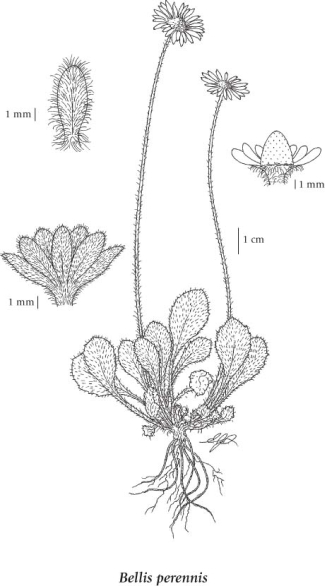Bellis perennis L.
English daisy (lawndaisy)
Asteraceae (Aster family)
Introduction to Vascular Plants
English daisy (lawndaisy)
Asteraceae (Aster family)
Introduction to Vascular Plants
Species Information
General:
Perennial herb from a fibrous root; stems ascending to erect, few, simple, leafless, hairy, 2-20 cm tall.
Leaves:
Basal leaves with short to long stalks, the blades spoon-shaped to oval or orbicular, 0.7-3.0 (rarely 4.0) cm long, 0.5-2.5 cm wide, toothed to entire, obtuse to rounded at the tips, coarse, spreading-hairy above and below; stem leaves lacking.Flowers: Heads with ray and disk flowers, solitary; involucres 5-6 mm tall; involucral bracts egg-shaped to broadly oblanceolate, rounded to obtuse at the tips, sparsely hairy on the backs, often suffused with purple; receptacles cone-shaped; ray flowers 8-10 mm long, white to sometimes pink or purple; disk flowers yellow.
Fruits:
Achenes appressed-hairy, mostly 2-nerved, flattened; pappus lacking. vol1_4
Illustration

If more than one illustration is available for a species (e.g., separate illustrations were provided for two subspecies) then links to the separate images will be provided below. Note that individual subspecies or varietal illustrations are not always available.
Illustration Source: The Illustrated Flora of British Columbia
Ecology
Ecological Framework for Bellis perennis
The table below shows the species-specific information calculated from
original data (BEC database) provided by the BC Ministry of Forests and Range.
(Updated August, 2013)
The table below shows the species-specific information calculated from
original data (BEC database) provided by the BC Ministry of Forests and Range.
(Updated August, 2013)
| Site Information |
Value / Class |
||
|
Avg |
Min |
Max |
|
| Elevation
(metres) |
732 | 706 | 810 |
| Slope
Gradient (%) |
4 | 0 | 15 |
|
Aspect (degrees) |
279 | 14 | 340 |
| Soil
Moisture Regime (SMR) [0 - very xeric; 4 - mesic; 8 - hydric] |
5 | 5 | 6 |
| Modal
Nutrient Regime
Class |
|||
| #
of field plots species was recorded in: |
11 | ||
| Modal
BEC Zone Class |
SBS | ||
|
All BEC Zones (# of stations/zone) species was recorded in |
SBS(11) | ||
|
Source:
Klinkenberg 2013
|
|||